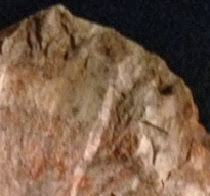Find by David Boies, Austin, Texas
The overall shape of the stone is a bird form in left profile
A human face on the bird's back, where the human's chin serves as the tail of the larger bird. A smaller protruding bird head form serves as the nose of the human.
Mark Jones find, Piney Point, Maryland, depicting a view of a vulture from behind with a human face depicted on its back and tail was featured in an earlier posting on this blog. The human's chin is the end of the bird's tail, just like in Mr. Boies Texas example.
The Maryland and Texas objects are made in the same culturally-mediated tradition, despite being found 1300 miles apart.


























.JPG)
+crop.jpg)











